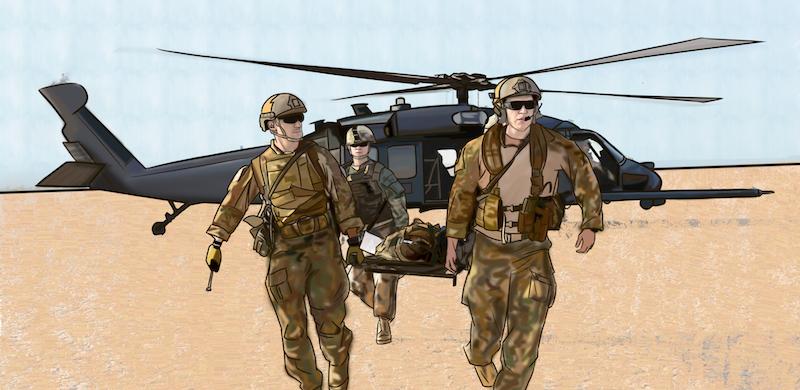The 129th Rescue Wing has a motto: Always ready, always there. Because that’s what they do — whenever the unit gets a call from the critically sick, injured or isolated, they pack up their civilian lives, board their aircrafts and save some lives.
Stationed at the heart of Silicon Valley in Moffett Federal Airfield, the 129th Rescue Wing is a reserve component of the United States Air Force that specializes in rescuing people. Specifically, they perform combat search and rescue, whether it be going into battle and pulling out a soldier who’s been pinned down, parachuting into the middle of the Pacific Ocean and finding a sailboat gone adrift, or sending medical help by strapping a surgeon to their bodies and then jumping out of a helicopter.
They’re also made up of people who live and work full-time in the Bay Area. Doctors, teachers, lawyers, firefighters — you name the job, and there’s someone from 129th represented there. So getting deployed means leaving not just their homes, but also their families and jobs.
It’s a busy lifestyle, and the last couple of months have been especially so. Hurricane Harvey, Irma, Maria, and the Northern and Southern California wildfires swept through the country, and the rescue wing has been there every single time.
Witness to tragedy
Captain Roderick Bersamina, the Public Affairs Officer of the 129th Rescue Wing, knows what tragedy looks like. He’s not a combatant, and he doesn’t train to pick up rifles and fight in wars, but he provides public affairs support and advice to commanders on strategic communication. This includes getting deployed right alongside soldiers.
While the Northern California fires raged through the Wine Country in October, for example, the unit sent their airmen right in the middle of the destruction on medical evacuation duty. Their focus on evacuation eventually shifted to active firefighting, which then shifted to supporting and rebuilding ruined cities. That’s where Bersamina came in.
“How do you build whole neighborhoods all over again? How do you build whole stores and hospitals and whatever other infrastructure that was out there?”
“How do you build whole neighborhoods all over again? How do you build whole stores and hospitals and whatever other infrastructure that was out there?”
— Captain Roderick Bersamina, 129th Rescue Wing public affairs officer
Deployed in the aftermath of the fires to coordinate media functions, Bersamina witnessed people in the process of losing everything. He recalls driving past a mobile home park on the way to the unit’s temporary base in Santa Rosa one day, and says it looked more like an empty, cement-covered field than it did a place where people used to eat, sleep and come home to.
“Clearly I wasn’t alive for this, but walking by and talking to folks, I’ve had comparisons to Hiroshima and Nagasaki,” he says. “It’s just leveled out. Where there once were homes, you can see clear across.”
Personal property wasn’t the only thing to suffer. Another focus of the mission at the wildfires was digging up personal effects — specifically, human remains.
“We were hoping to identify as many people as possible,” Bersamina says. “As a grieving family, you hope that those remains are not the person you’re missing.”
Rebuilding the destruction
Even when he’s talking about tragedy, Bersamina doesn’t show much emotion. He’s nothing if not professional, and articulates his speech with a formal concision that’s telling of his experience in the field. He doesn’t dwell too long on events that happened in the past, and keeps his focus on getting things done to improve the future.
That being said, he’s certainly not lacking in passion for his job, and it noticeably shows as he zones in on rebuilding efforts.
“How do you build whole neighborhoods all over again?” Bersamina says. There’s a determined fervor that accents his words as he lets loose. “How do you build whole stores and hospitals and whatever other infrastructure that was out there?”
The answer came in the form of a tent city. While soldiers sifted through post-fire ash looking to reunite individuals, a coordinated effort between all the various agencies of the California National Guard to build a temporary city complete with electricity, portable showers and toilets took place. In addition to serving as an emergency operations center, it also acted as a shelter for displaced soldiers so that rebuild efforts could effectively continue.
“As devastating as it was, and as heartbreaking as it was to hear some of the stories from these affected individuals, it was also very heartening to see the amount of volunteerism that was out there,” Bersamina says.
The 129th Rescue Wing is an extraordinary group — whatever the occasion, the unit is ready to respond. But while its soldiers bear a weighty responsibility, they’re still people who live in and care about their local community.
“What I hope people understand is we’re just like everybody else,” Bersamina says. “But we take pride in answering that greater calling to serve.”




